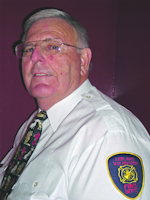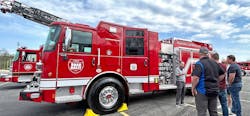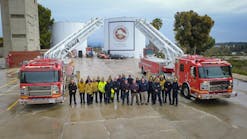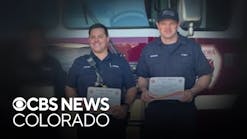KENN FONTENOT is the National Volunteer Fire Council’s Louisiana director and chair of the NVFC Health and Safety Committee. He is also a charter member and first fire chief of the LeBlanc Volunteer Fire Department. Fontenot is a principal member of the NFPA 1001 committee and alternate member of the NFPA 1021 committee. He also is the regional fire training coordinator at the Louisiana State University Fire and Emergency Training Institute and a past president of the Louisiana State Firemen’s Association. He holds an associate’s degree in fire science.
pull quote with opening art of NVFC logo
As long as a single firefighter is killed or injured from a preventable cause, such as not wearing a seatbelt, then we haven’t done all that we can do to protect our personnel.
LEAVE SPACE FOR A CHART ON THE SECOND PAGE
It is a tragedy we should never see happen – a firefighter’s life cut short because of a vehicle accident. Yet each year, 25% of all line-of-duty deaths involve vehicle crashes. Many of these lives could have been saved if only the firefighter had taken a second to buckle their seatbelts. What can we as the fire service do to prevent these tragedies and how can we create a culture within our departments where seatbelt use and vehicle safety is a top priority?
A focus on vehicle safety is paramount if we are to reduce the number of line-of-duty deaths and injuries of firefighters, yet the nature of the fire service includes years of tradition and stubborn personalities. Changing vehicle behaviors, including wearing seatbelts, is extremely difficult, particularly for volunteers. In struggling communities desperately trying to recruit and retain members, it is hard to consider implementing new or stricter standard operating procedures (SOPs) and increasing training requirements. That, however, is exactly what needs to be done in order to create a culture within a department where safe driving and seatbelt use is expected and adhered to.
Statistics show that we are not doing enough. As long as a single firefighter is killed or injured from a preventable cause, such as not wearing a seatbelt, then we haven’t done all that we can do to protect our personnel. The U.S. Fire Administration (USFA) reports that over the past decade, an average of 15 firefighters died in vehicle crashes each year. In 2009, there were 16 on-duty fatalities caused by vehicle crashes – nine involving fire department apparatus, two involving personal vehicles and five involving aircraft. This is way down from the 28 deaths in 2008, but while we are heading in the right direction, we must do better.
In many of the cases reported in 2009, seatbelts were not used or were not available in older apparatus. According to a report released by the National Fire Protection Association (NFPA), driver inattention, weather conditions, lack of vehicle maintenance, minimal safety features on older apparatus, and excessive speed were found to be contributing factors in the fatalities.
In addition, the NFPA reports that 820 firefighters were injured in 2009 as a result of collisions involving fire department emergency vehicles. Another 870 collisions were reported in personal vehicles while the departments were responding to or returning from incidents, resulting in another 100 injuries.
Yet, to many firefighters these statistics are just numbers. Sad numbers, yes, but not creating a profound enough impact to inspire changes to their driving or seatbelt behaviors. The numbers don’t become real until a vehicle accident happens to them or someone they know. But by then it’s too late. We need to hammer the point home and get through to our departments’ members now – before the worst happens.
So what can we do? First, we must make it clear that “Safety Tops Our Priorities” (STOP). Department leaders need to instill the values of safe driving and using seatbelts from the top down. While you may not want to ruffle feathers and risk annoying valued and needed department members, the alternative is far worse. When your members’ safety is on the line, you can’t afford not to take a stand. You must make it clear that vehicle safety is not optional, and to be part of the team all members must adhere to the requirements.
There are several NFPA standards that departments can look to when developing their own policies. These include:
• NFPA 1911 – Standard for the Inspection, Testing, Maintenance and Retirement of In-Service Automotive Fire Apparatus, which outlines apparatus service and maintenance programs to keep them in safe operating conditions.
• NFPA 1002 – Standard on Fire Apparatus Drive/Operator Professional Qualifications which outlines the minimum requirements for apparatus drivers and operators in emergency and non-emergency situations.
• NFPA 1500 – Standard on Fire Department Occupational Safety and Health Program, which includes protocols indicating that apparatus operators successfully complete approved driver training programs and operate the vehicle in accordance with traffic laws. It also indicates that all occupants will be sitting and restrained with a seatbelt prior to movement of the vehicle.
Departments also must establish and enforce policies and procedures that require safe vehicle behaviors, including seatbelt use. The National Volunteer Fire Council (NVFC) has collaborated with the USFA to help volunteer departments develop and implement vehicle safety policies. The Emergency Vehicle Safe Operations for Volunteer and Small Combination Emergency Service Organizations program includes best practices, motivational practices and standard operating guidelines (SOGs) to help volunteer and small combination departments decrease the risk of fatalities, injuries, costs and reduced efficiency associated with vehicle crashes.
The NVFC also has partnered with McNeil and Co.’s Emergency Services Insurance Program (ESIP) to develop a “STOP” training program designed to instill in emergency personnel the importance of first responder safety behind the wheel and train them in safe operational practices. The campaign aims to increase awareness and safe operational practices in the area of driver and road safety in apparatus as well as personal vehicles. Departments and local and regional emergency service organizations can use this training as part of their efforts to reduce the risk of firefighter death and injury from vehicle accidents.
The campaign will launch with the first training session in the program, “STOP: Seatbelts Top Our Priorities.” As the title suggests, this first training module focuses on vehicle safety with an emphasis on seatbelt use. The 30-minute online training contains completion tracking capabilities so departments can ensure their members have completed the course. Certificates of completion are available. See www.nvfc.org for more information on the “STOP” campaign and the first course.
In addition to safe vehicle and seatbelt training, the NVFC encourages departments to have all their members sign the International First Responder Seat Belt Pledge. The pledge was created in 2006 in memory of Firefighter Brian Hunton of the Amarillo, TX, Fire Department, who died in 2005 after falling from his apparatus on the way to a call. The pledge is supported by many national fire service agencies and groups, including the NVFC, NFPA, National Fire Academy, National Fallen Firefighters Foundation (NFFF), International Association of Fire Chiefs (IAFC) and National Institute for Occupational Safety and Health (NIOSH). More than 850 departments and 150,000 firefighters have signed the pledge, making the commitment that they will improve their safety by wearing their seatbelts. The entire NVFC Board of Directors signed the pledge in 2010 to show their support for the campaign. In 2011, the NFFF incorporated the International First Responder Seat Belt Pledge into the Everyone Goes Home Campaign. Find the pledge and additional resources at everyonegoeshome.com/seatbelts.
Seatbelt use and safe vehicle practices are the easiest things first responders can do to protect themselves from preventable injury and possible death. Simple precautions like clicking a seatbelt and watching your speed significantly reduces the risk that a first responder will be killed or injured in a vehicle accident. We need to STOP ignoring the problem and start creating a culture in the fire service that expects and respects vehicle safety.

Kenn Fontenot
KENN FONTENOT is the National Volunteer Fire Council’s Louisiana director and chair of the NVFC Health and Safety Committee. He is also a charter member and first fire chief of the LeBlanc Volunteer Fire Department. Fontenot is a principal member of the NFPA 1001 committee and alternate member of the NFPA 1021 committee. He also is the regional fire training coordinator at the Louisiana State University Fire and Emergency Training Institute and a past president of the Louisiana State Firemen’s Association. He holds an associate’s degree in fire science.





